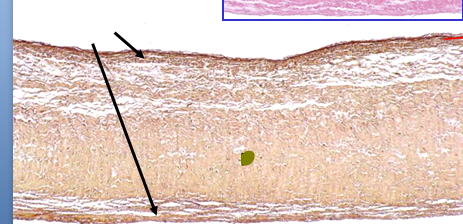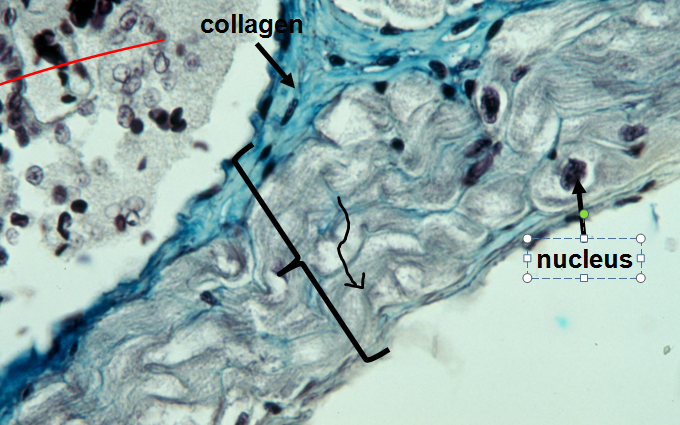Cardiovascular Histology Quiz
(599).jpg)
Histology of the study of cells/tissue under a microscope. In this cardiovascular histology quiz, you will identify the CV lab slides and answer any relevant questions about Cardio histology Answering all the questions is compulsory. This quiz can be used as a means to prepare for upcoming examinations. Therefore, attempt the quiz well. You can try this quiz with some of your friends for excellent group preparation. Keep studying hard and prepare well.
- 1.
What is the thickest layer in the ventricular wall?
- A.
Myocardium
- B.
Epicardium
- C.
Endocardium
- D.
Ectocardium
- E.
All layers have the same thickness
Correct Answer
A. MyocardiumExplanation
The myocardium is the correct answer because it is the thickest layer in the ventricular wall. The myocardium is the middle layer of the heart wall and is composed of cardiac muscle tissue. It is responsible for the contraction of the heart, pumping blood throughout the body. The epicardium is the outermost layer, the endocardium is the innermost layer, and the ectocardium is not a recognized term. All layers of the ventricular wall do not have the same thickness, making myocardium the correct answer.Rate this question:
-
- 2.
An endocardium does not have which of the following?
- A.
Elastin
- B.
Collagen
- C.
Muscle cells
- D.
Endothelial cells
- E.
None of the above
Correct Answer
C. Muscle cellsExplanation
The endocardium is the innermost layer of the heart, and it is responsible for lining the chambers and valves. It primarily consists of endothelial cells, which form a smooth surface to facilitate the flow of blood. The endocardium also contains collagen and elastin, which provide structural support and elasticity to the heart. However, it does not contain muscle cells, as the muscular layer of the heart is called the myocardium, which is located beneath the endocardium. Therefore, the correct answer is "muscle cells."Rate this question:
-
- 3.
Which layer in the heart is mainly responsible for generating force?
- A.
Epicardium
- B.
Myocardium
- C.
Endocardium
- D.
Ectocardium
- E.
All of the above
Correct Answer
B. MyocardiumExplanation
The myocardium is the correct answer because it is the middle layer of the heart and is primarily responsible for generating the force needed to pump blood throughout the body. It is composed of cardiac muscle cells that contract and relax to create the pumping action of the heart. The epicardium is the outermost layer, the endocardium is the innermost layer, and the ectocardium is not a recognized term in relation to the layers of the heart.Rate this question:
-
- 4.
This layer contains the adipose tisse, a fibrioelastic CT, and mesotheliam (a linglr later of low cuboidal sqamys epithelial cells.
- A.
Epicardium
- B.
Myocardium
- C.
Endocardium
- D.
None of the above
Correct Answer
A. EpicardiumExplanation
The correct answer is epicardium. The given description mentions that this layer contains adipose tissue, fibrioelastic CT, and mesotheliam. The epicardium is the outermost layer of the heart and it consists of connective tissue, adipose tissue, and a layer of mesothelial cells. Therefore, it matches the given description. The myocardium refers to the middle layer of the heart, composed of cardiac muscle tissue. The endocardium refers to the innermost layer of the heart, consisting of endothelial cells. None of these layers match the given description.Rate this question:
-
- 5.
What kind of cells are in this layer that the arrow is pointing to?
- A.
Cuboidal/squamus cells
- B.
Pseudostratified columnar cells
- C.
Simple columnar cells
- D.
None of the above
Correct Answer
A. Cuboidal/squamus cellsExplanation
cuboidal/squamus cells in the mesothelium layer of the epicardium.Rate this question:
-
- 6.
Which layer is not seen in a heart valve?
- A.
Endocardium
- B.
Myocardium
- C.
Epicardium
- D.
None of the above
Correct Answer
C. EpicardiumExplanation
The myocardium is the middle layer of the heart wall and is responsible for the contraction of the heart muscle. It is present in all parts of the heart, including the valves. Therefore, the myocardium layer is seen in a heart valve.Rate this question:
-
- 7.
The arrows the pointing to what in a heart valve?
Correct Answer
ElastinExplanation
The green dot is where the collagen lies in a heart valve.Rate this question:
- 8.
Purkinje fibers are located in which of the heart layer?
- A.
Endocardium
- B.
Myocardium
- C.
Epicardium
- D.
None of the above
Correct Answer
A. EndocardiumExplanation
Purkinje fibers are specialized cardiac muscle fibers that are responsible for transmitting electrical signals throughout the heart. They are located within the endocardium, which is the innermost layer of the heart. The endocardium lines the chambers of the heart and covers the heart valves. Therefore, the correct answer is endocardium.Rate this question:
-
- 9.
What is the arrow pointing to ?
Correct Answer
Purkinje fibersExplanation
The arrow in the question is pointing to Purkinje fibers. Purkinje fibers are specialized cardiac muscle fibers that are responsible for transmitting electrical signals throughout the heart. They are located in the ventricles and help coordinate the contraction and relaxation of the heart muscle, ensuring efficient pumping of blood.Rate this question:
- 10.
What is the derivative of valves in the veins?
- A.
Tunica media
- B.
Endothelium
- C.
Vasa vasorum
- D.
None of the above
Correct Answer
B. EndotheliumExplanation
The endothelium is the innermost layer of cells lining the blood vessels, including the veins. It plays a crucial role in regulating vascular tone and permeability, as well as in the release of various vasoactive substances. The derivative of valves in the veins is not applicable to this question, as valves are not directly related to the endothelium. Therefore, the correct answer is Endothelium.Rate this question:
-
Quiz Review Timeline +
Our quizzes are rigorously reviewed, monitored and continuously updated by our expert board to maintain accuracy, relevance, and timeliness.
-
Current Version
-
Oct 18, 2024Quiz Edited by
ProProfs Editorial Team -
Jan 05, 2011Quiz Created by
Dolatahera19
 Back to top
Back to top





